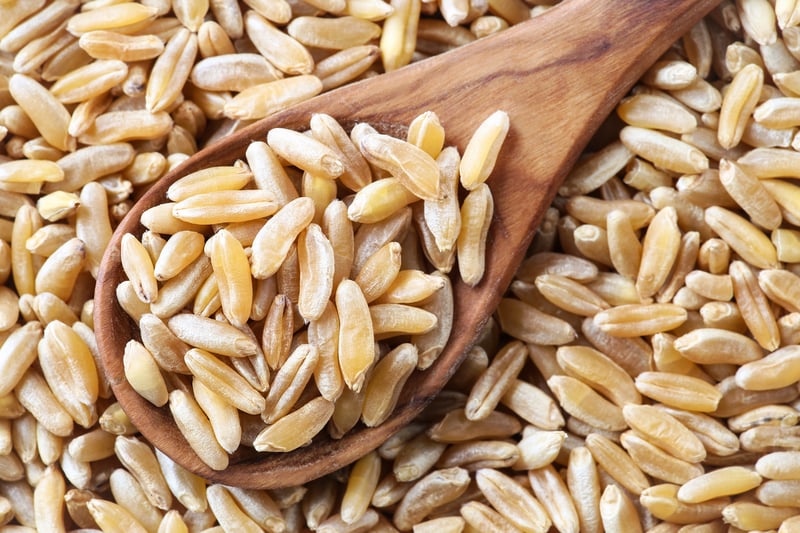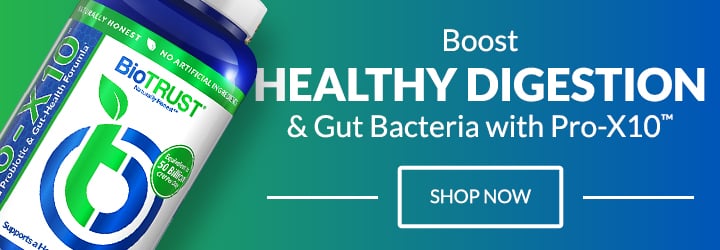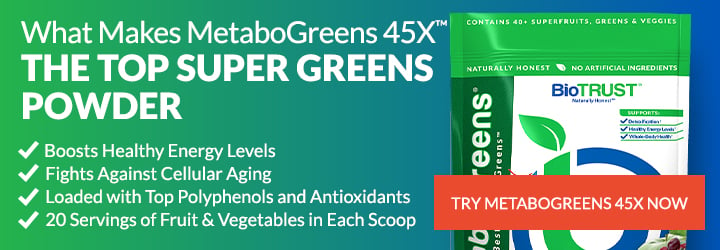22 Foods That Are Surprisingly High in Protein (#19 is Crazy!)

You already know that high-protein foods are part of a healthy diet, and a high-protein diet is one of the most popular diets to follow—for good reason! High-protein diets can be especially effective for you if you:
- Are an athlete
- Exercise intensely three or more times per week
- Want to lose fat and add muscle tone
- Want to build muscle
- Want to lose weight or maintain your current weight
- Struggle with appetite or out-of-control cravings
- Are older than 50
- Are recovering from an injury
Even if you don’t fit in one of the above categories (who doesn’t?), protein is crucial for virtually every cell in your body. It provides the building blocks for ligaments, muscles, organs, skin, blood, and more.
Proteins are used to build and repair tissues, and the body uses the amino acids that make up dietary proteins to create enzymes, hormones, antibodies, neurotransmitters, and transportation chemicals.
Research has found that high-protein foods help rev up the metabolism, keep you feeling full longer, fight cravings, reduce caloric intake, and improve diet quality to support weight loss.
Yet if you’re eating high-protein foods with every single meal, it can be easy to feel like you’re in a rut. Grilled chicken or fish again? Another protein powder smoothie? Eggs every morning?
As wonderful and versatile as those high-protein foods can be, sometimes you just want to branch out and try something different. Fortunately, there are a lot of high-protein foods beyond the usual suspects. I think you’ll be surprised by at least a few of them!
22 Surprisingly High-Protein Foods
1) Black bean spaghetti (25 grams of protein and 180 calories per 2 ounces): While fresh zoodles and other vegetables are all the rage when it comes to low-carb pasta alternatives, another option is to use a non-flour-based pasta made from beans. Dried pastas made from beans have a taste and texture that’s more like the “real” thing but provide way more protein and fiber (12 grams per serving).
2) Simply legumes pasta (21 grams of protein and 300 calories per 3 ounces): Another non-flour pasta option is that made from legumes. There’s a wide variety of sizes and shapes (from elbows to rotini), and most are made from a single ingredient: legumes. They also provide 11 grams of fiber per serving.
3) Chickpeas or garbanzo beans (19 grams of protein and 365 calories per ½ cup): Part of the legume family, chickpeas have been a mainstay of traditional Middle Eastern cuisine for thousands of years. They are very versatile, they’re rich in vitamins, minerals, and fiber, and they may improve digestion, support weight management, and decrease the risk of disease. No wonder they’re so popular for vegetarians and meat-eaters alike!
4) Plain Greek yogurt (21 grams of protein and 190 calories per cup): By straining the liquid whey from yogurt, you’re left with a thick, creamy, tart yogurt that provides calcium, probiotics, iodine, and vitamin B12 along with plenty of protein.
5) Lentils (18 grams of protein and 230 calories per cup): Ranging in color from yellow to red to green to black and brown, lentils are rich in protein as well as a plethora of phytonutrients, polyphenols and other bioactive compounds. They’re highly nutritious as well as inexpensive and make a great alternative to meat, especially as they are also a good source of iron (at 37% of the recommended daily intake).
6) Tempeh (15.5 grams of protein and 160 calories per half cup): This popular vegetarian meat replacement is made from fermented soybeans. Not only is it a high-protein food, but tempeh also provides prebiotics for a healthy gut and a range of vitamins and minerals, including manganese, phosphorus, magnesium, and calcium. It’s also very versatile. It’s important to note that traditionally fermented soybean dishes such as tempeh do not carry the same potential negative side effects as typical heavily processed soy-based ingredients (e.g., soybean oil, soy protein isolate).
7) Hemp seeds/hearts (14 grams of protein and 212 calories per ¼ cup): Exceptionally nutritious, including omega-3 and gamma-linolenic acid fatty acids, high-quality complete protein, and minerals like phosphorus, potassium, magnesium, sulfur, calcium, iron, and zinc, as well as vitamin E, hemp seeds have a mild nutty flavor that complements many dishes.
8) Cottage cheese (13 grams of protein and 111 calories per ½ cup): Low in calories, high in essential nutrients like vitamin B12, selenium, and phosphorus, and mild in flavor, cottage cheese has long been recommended to virtually all athletes and folks on weight-loss plans. It’s found in countless recipes due to its versatility.
9) Oats (13 grams of protein and 303 calories per ½ cup, dry): The humble oat has been shown in research to support weight loss, reduce blood sugar levels, and decrease the risk of heart disease. It is also well-balanced when it comes to nutrition, providing slow-digesting smart carbs, 8 grams of fiber (including beta-glucan), and more protein and fat than most other grains. It’s also an impressive source of manganese, phosphorus, vitamin B1, magnesium, copper, iron, and zinc as well as antioxidants like avenanthramides.
10) Kamut (11 grams of protein and 251 calories per cup): This forgotten grain is making a big comeback due to its high nutritional value, creamy, buttery taste, and unusual texture. It’s also high in zinc, magnesium, selenium, polyphenols, and fatty acids.
11) Parmesan cheese (11 grams of protein and 122 calories per ounce): This hard, aged cheese provides tons of nutrients, including calcium and phosphorus, which support bone formation and health. It’s also low in lactose, and just a little bit can strongly enhance the flavor of many dishes.
12) Veggie burgers (protein and calories vary): If you’re looking at a store-bought veggie burger, please read the label carefully. Veggie burgers may not be as healthy as claimed, as they are often made with heavily processed, highly refined ingredients. When you make your own, however, veggie burgers can be amazingly delicious and nutritious sources of protein, vitamins and minerals, and antioxidants.
13) Amaranth (9 grams of protein and 251 calories per cup): One of the grains that was once a staple of Inca, Mayan, and Aztec civilizations, this pseudo-cereal is making a big comeback due to its rich nutritional content. It’s high in protein and fiber as well as many micronutrients like manganese, magnesium, phosphorus, and iron.
14) Green peas (8 grams of protein and 124 calories per cup): While often categorized as a vegetable, peas are actually a legume (like lentils and chickpeas). Whether pulled from the frozen, fresh, or canned section of the grocery store, peas are filling and satisfying due to their combination of complex starches, fiber, and protein. They also provide plenty of polyphenols, which offer numerous health benefits, including antioxidant properties.
15) Quinoa (8 grams of protein and 222 calories per cooked cup): Perhaps the most popular and nutritious of the ancient grains (although it’s technically a seed), quinoa is a source of complete protein that’s also high in fiber, magnesium, B vitamins, iron, potassium, calcium, phosphorus, vitamin E, as well as antioxidants like the flavonoids quercetin and kaempferol. It’s available in three main varieties: red, white, and black, which are all highly versatile and easy to prepare.
16) Peanut butter (8 grams of protein and 188 calories per 2 tablespoons): Another highly popular food in the U.S., peanut butter is an inexpensive, readily available source of protein. Unfortunately, nut butters often are also loaded with unnecessary additives, so look for a nut butter that’s made up of just nuts (perhaps with a bit of salt).
17) Milk (8 grams of protein and 148 calories per cup of whole milk): Designed as the perfect food for newborns during their first months of life, milk (in this case, cow’s milk) is a highly complex, nutrient-rich food. Milk is made up of two main proteins: the slow-digesting casein (80%) and faster-acting whey (20%). It also provides a complex of around 400 different fatty acids, including saturated fats (about 70% of the fat content) and monounsaturated fats (about 28%).
18) Pumpkin seeds (7 grams of protein and 151 calories per ounce): Good things do come in small packages. Even a single ounce of these small, green, flat seeds packs a powerful nutritional punch, including zinc, manganese, magnesium, phosphorus, vitamin K and B2, along with loads of antioxidants like carotenoids as well as fiber.
19) Cricket flour/powder (6 grams of protein and 50 calories per 10-gram serving): A rising star among high-protein foods is cricket flour or powder. Yes, it really is made up of milled crickets. Eating insects is nothing new — it’s been done for millennia — but only recently has cricket flour made its entrance in response to increased calls for sustainability. Cricket-based foods are eco-friendly as they require significantly less feed per kilogram harvested, less water, and less space, and they also generate way less greenhouse gas. Crickets are also cleaner than cows and chickens and have been found to carry fewer diseases and infections.
Crickets are a good source of complete protein, rich in minerals, a good source of fatty acids, and high in B vitamins. While you can just munch on seasoned crickets, cricket powder, which can be added to baked goods, soups and even smoothies, removes the legs and antennas and doesn’t noticeably change the flavor. Other high-protein insects you can add to your diet include mealworms, locusts, grasshoppers, water bugs, grubs, and even scorpions (just make sure to remove the stinger first!).
20) Chia seeds (5 grams of protein and 138 calories per ounce): These tiny balls of nutrition provide fiber, healthy fats, antioxidants, vitamins, minerals, and complete proteins. Chia seeds are easy to add to just about any meal plan. Include a spoonful in smoothies, on top of yogurt or oatmeal, in soups and salads, in baked goods, or, my personal favorite, in pudding.
21) Corn/maize (5 grams of protein and 177 calories per cup): This ubiquitous grain (nope, it’s not a vegetable and is instead a member of the grass family) is rich in fiber, vitamins like B12 and folic acid, minerals like iron, antioxidants, and fiber. We’re most familiar with the yellow variety, but corn also comes in red, orange, purple, blue, white, and black. Who knew? Skip heavily processed corn-based products like tortillas and chips and go for the fresh or frozen whole-grain non-GMO sweet corn instead.
22) Spirulina (4 grams and 20 calories per tablespoon): This “super sea vegetable” is considered one of the most protective, healing ingredients because of its incredible nutrient profile and benefits. Not only is it a complete protein, but it’s also rich in vitamin B12, beta-carotene, vitamin E, potassium, calcium, essential fats, and more.
With such a wide variety of high-protein foods, it’s much easier to get the recommended 0.7 to 1.0 grams of protein per pound of body weight per day to support those who want to look, feel, and perform better.








